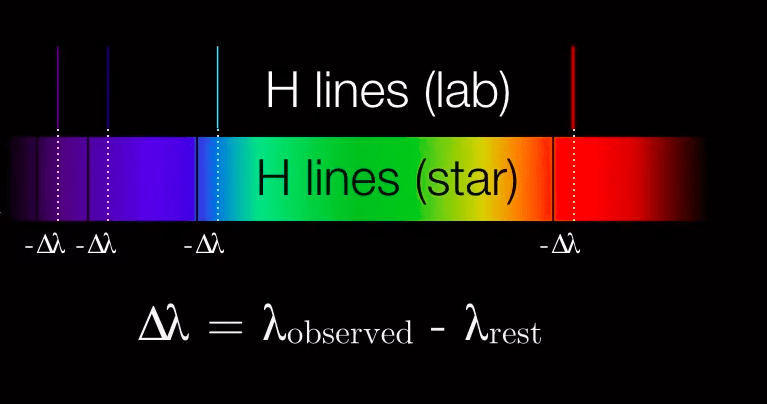In Astronomy, the Doppler effect is used to determine if a galaxy or a star is approaching us or moving away from us. The Doppler effect is also used to determine the rate at which that galaxy or star is moving. This is determined with the help of the redshift ( moving away ) or the blueshift ( moving towards ) of the light coming off of the star. The doppler shift is normally represented as Δλ.
We have already spoken about doppler effect in radars, like radars light is also a electromagnetic wave and just like any electromagnetic wave, light also experiences doppler effect and contracts or stretches based on the whether it is moving towards or away from the reference and also because of the expanding nature of the universe.
Since the dual nature ( behaves as both particle and wave ) of the light, doppler effect cannot happen on the particle medium and so the wave medium which is the spectrum of the light changes which cause the light wave to stretch and increases the wavelength and moves the light to red side when it is moving away and contracts, decreasing the wavelength moving the light to blue side. Thus the name RedShift and BlueShift.


How Does Doppler Shift Make Sense on a Star?
Just because the light from a star is red, one cannot determine that the star is moving away from the reference point.
So, in order to determine whether a star is moving away from the reference or toward the reference object, a clever tactics is used.
The light from the star is passed through a prism and a spectrum is generated. Then the absorption line of the Hydrogen in the Star atmosphere is compared with the absorption line of the Hydrogen in the rest which is calculated in the lab.
So the change is used to determine the redshift or the blueshift.
That is,
Δλ = Δobserved - Δrest
So when a star is moving towards us, The observed wavelength will be shorter than the rest wavelength resulting in a negative Δλ.
Likewise, when the object moves away from the reference point, the observed wavelength will be greater than that of the rest, resulting in a positive Δλ.
Δλ > 0 → RedShift ( Moving Away )
Δλ < 0 → BlueShift ( Moving Towards ) Doppler shift determines the rate at which object is moving.
Now that we know the doppler shift Δλ of the object, This is used to determine the speed at which an object is moving towards or away. The velocity in which the object moves is called Radial Velocity ( vr ).

For example, A star’s observed wavelength on the hydrogen beta line is 486.11 nm. The rest beta line for hydrogen atom is 486.10nm. The difference between the both is 0.01nm.
Since the Value is positive, the star should be moving away from the reference.
How fast is the star moving away?
To find that, we substitute the value into the Radial Velocity formula.


So, the above example proves that even a really small change in the shift of the wavelength results in a really huge velocity. This is how scientists use doppler shift in astronomy to determine the velocity of the object in space.



Pingback: 20 Applications of Doppler Effect - LIDAR and RADAR
Pingback: Active Radar vs Passive Radar - LIDAR and RADAR
Hi
I think there is a mistake in calculation
486.11-480.10=0.01 ??????
Yes, The rest beta is 486.1. Rectifying it and updating the post.
there is same mistake in photo(solution) it wrote 480.01
Thank you so much for pointing it out. Just figured it out and Rectified it.